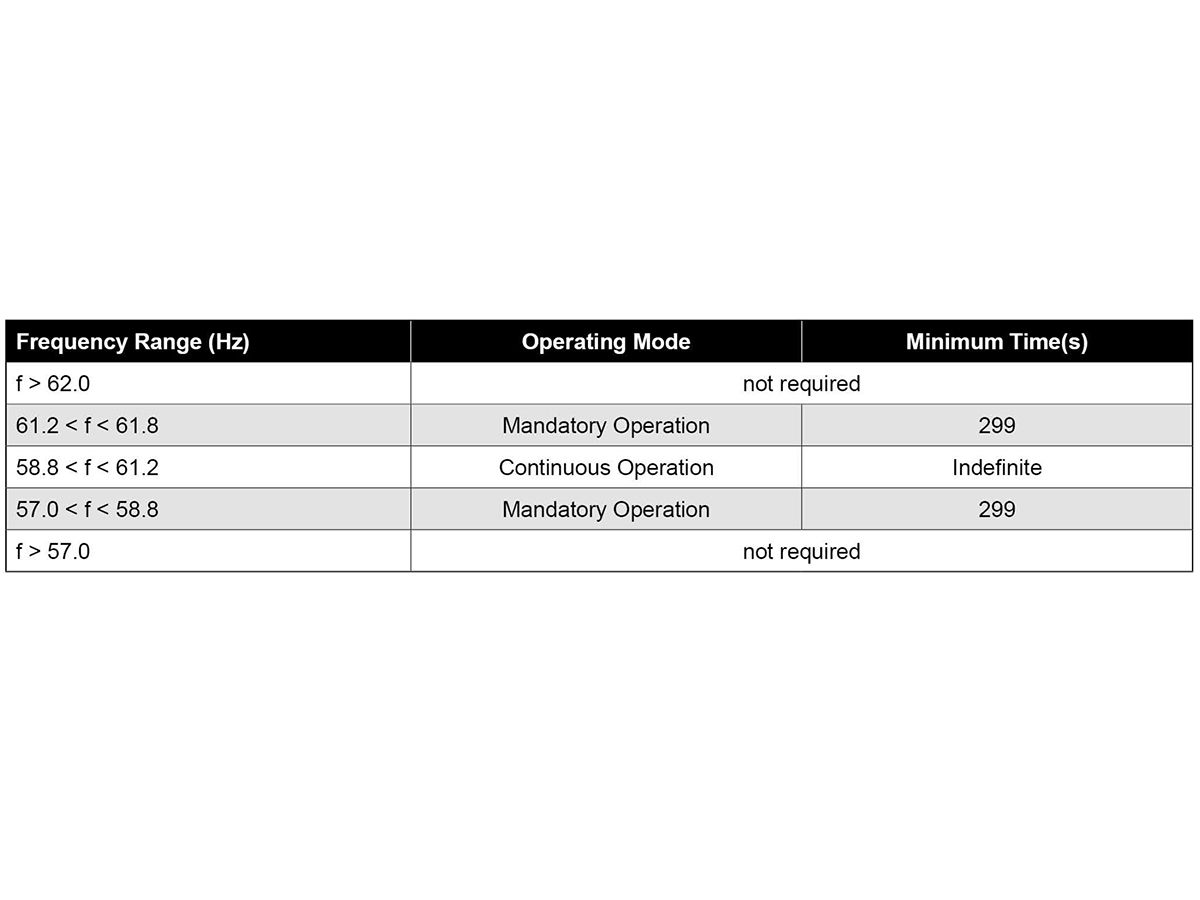Most of these accuracies are achievable in typical genset controls, but some have not been traditionally measured to the higher levels of accuracy now specified. In the past, there has been no need to measure frequency to a precision of 10 MHz. Likewise, time measurements have been primarily used for event time stamping, and precise time measurements lie within protective relay functions. In some cases, genset controls measurements are heavily filtered and it should be verified that the filtering falls within the allowable measurement windows given in the standard.
Mandatory Tripping Requirements
DERs, gensets in the industry, are required to detect Area EPS faults, such as short-circuit faults or open phase conditions, and trip accordingly. Also, abnormal voltage and frequency tripping conditions are specified. Tables 2 and 3, give, respectively, thresholds for voltage (category I only) and frequency (all categories) tripping.
The must trip conditions are specified in terms of not later than the specified values, while the ride-through requirements are specified in terms of tripping not sooner than specified values. Whenever there is a gap between the ride-through and the tripping thresholds the DER is allowed to either continue to operate or trip. This creates a buffer zone where trip setting can be set to avoid out of compliance tripping. Tables 4, 5, and 6 show voltage ride-through requirements for categories I and II, respectively, and frequency ride-through requirements for all categories.
Island Detection
The standard requires that for an unintentional island in which the DER energizes a portion of the Area EPS through the PCC (point of common coupling), the DER must detect the island, cease to energize the Area EPS, and trip within 2 s of the formation of an island. If a DER falsely detects an island that does not actually exist and interrupts its ride-through during a grid event, the DER would be considered noncompliant.
Most inverter based DERS are equipped with autonomous islanding detection means. To ensure robustness on islanding detection by inverters the standard specifies test methods that involve resonant circuits at grid frequencies. Given that the standard is technology neutral, the same testing methodology is to be used for synchronous generators. It is unlikely that synchronous generators using some form of autonomous islanding detection would be able to pass the islanding detection compliance tests. Push-pull frequency methods for islanding detection have been proven to be ineffective for islanding detection under the given testing conditions. Other known methods are not compatible for implementation with rotating machinery. External means for islanding detection would probably be required. Some relay protection manufacturers claim that their equipment is IEEE 1547, and they may be able to provide a solution. However, it is likely that utilities may require additional protections such as direct transfer trip (DTT). A more affordable alternative would be advanced powerline carrier systems. These systems typically come at a fraction of the cost of DTT systems.
Interoperability
The standard requires that a DER must have provisions for a local DER interface capable of communicating to support the information exchange communication requirements specified in this standard for all applicable functions that are supported in the DER. For information interoperability, these communication capabilities use unified information models and non-proprietary protocol encodings based on international standards or open industry specifications.
The information to be exchanged falls into the following four categories:
- Nameplate information (read only information indicative of the as-built characteristics of the DER)
- Configuration information (read or write information indicative of the present capacity and ability of the DER toperform functions)
- Monitoring information (read only information indicative of the present operating conditions of the DER)
- Management information (read or write information used to update functional and mode settings for the DER)
The DER must support at least one of the protocols specified in the Table 7. The protocol to be utilized may be specified by the Area EPS operator. Additional protocols, including proprietary protocols, may be allowed under mutual agreement between Area EPS operator and DER operator.
Summary and Conclusions
Distributed generation resources will need to comply with IEEE Standard 1547 if they are to connect to the electrical grid. The 2018 edition of the standard has been extensively revised requiring fault ride-through capabilities, and several additional functions have been added for grid support purposes. The companion compliance test standard, IEEE Standard 1547.1, was published in 2020, and the associated certification standard UL 1741, Edition 3 was just published on September 28, 2021. Enforcement of IEEE 1547 requirements is expected to be phased in during 2022, but adoption is not going to be uniform, with some states being early adopters and others lagging behind.
At the time of this writing, most gensets (from any manufacturer) would not be in compliance with the new version of the standard, and they would not be allowed to connect to the grid if the local jurisdiction enforces the standard. The path to demonstrate compliance would be through UL1741, Edition 3 certification*. Note that the standard does not apply to automatic transfer schemes in which load is transferred between the DER and the EPS in a momentary make-before-break operation provided the duration of paralleling the sources is less than 100 ms. Therefore, standby generators would be typically exempt from the standard, but grid connected generators would have to comply with the standard. It is outside the scope of this paper to point out what requirements (within the 134 pages of IEEE Standard 1547-2018) would, or would not, be met by most generator sets offered by the industry, but to raise awareness of major changes driven by the new standard.
*Caterpillar, while closely following the regulation changes, is in the process of introducing grid compliant productsconcurrent with the effectivity date of the regulations. Consult your Cat dealer for specific adoption timeframes foryour local jurisdiction. Please refer to the Dealer Locator at www.cat.com to find your local dealer.
















